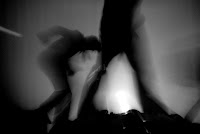 Sometimes it may create tension and suspense by using shadows to mask or conceal elements.
Sometimes it may create tension and suspense by using shadows to mask or conceal elements.Different types of lighting:
The Key Light is the brightest and the most influential.
The Back Light helps to balance the effect of the Key Light making the character or object look more 'rounded'.
The Filler Light helps to soften harsh shadows that the Key Light and Back Light create. Usually may be more than one Filler Light.
The Key Light can be directed from different angles to create different effects .
Underlighting is when the main source of lighting comes from below the subject. This tends to distort the character or object that is being lit, and is often used in Horror films.
Top Lighting is when the main source of lighting comes from above, highlighting the features of a character. This technique is often used to create a glamorous look in a star.
Back Lighting is when the light source is behind the subject. If little or no other lighting is used, silhouettes are created.
Low-key & High-key Lighting
Low-key lighting is created by using only by using the key and back lights. This creates a sharp contrast of light and dark areas on the screen.
High-key Lighting means that more fillers are used. High-key lighting appears normal and realistic to our eyes.
No comments:
Post a Comment